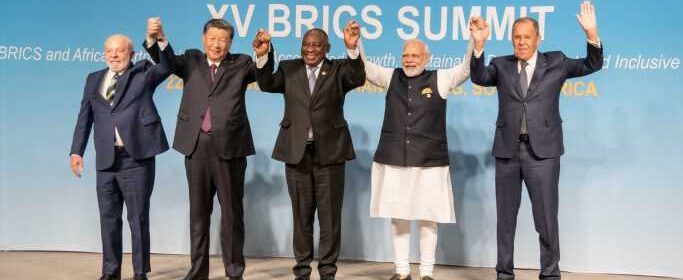New World Order? How BRICS Economies Have Surpassed US and Europe

It is official. Starting on Jan. 1, the five-nation BRICS alliance will expand, adding six more nations. For brevity’s sake, let us just call it the BRICS+.
The original BRIC bloc of Brazil, Russia, India, and China held its first summit during the last major global economic crisis in 2009 with a mission of countering Western global economic dominance. A year later, South Africa signed up, adding the “S” to BRICS. The original acronym was coined in 2001 by former Goldman Sachs economist and former U.K. Treasury Minister Jim O’Neill.
Six more developing countries joined the league during the 15th BRICS Summit in Johannesburg in August: Argentina, Egypt, Ethiopia, Iran, Saudi Arabia, and the United Arab Emirates.
With this expansion, nearly 3.7 billion people, or about 46% of the world’s population are now part of BRICS+. China and India alone account for over 35% of the world’s population. These countries together hold 29% of global gross domestic product, 22% of exports, and 42% of global oil output.
By comparison, the Group of Seven nations and the European Union make up 1 billion people, or about 12.7% of the world’s population. However, they hold 51% of global GDP and 47% of exports. The U.S. alone accounts for a quarter of the world’s GDP, while the EU accounts for over 16%. G7 nations (without the EU) produce 27% of global oil output, but most of this comes from the United States. (Also see, the most innovative countries.)
The 11 countries of BRICS+ have much higher rates of population growth, though the average life expectancy is far lower compared to the Western G7 and EU nations. While G7 and EU countries, with the exception of the U.S., all have life expectancy above 80 years, all 11 BRICS nations have life expectancy below 79 years.
The expanded BRICS countries are also more authoritarian and corrupt, according to two widely used measures. And GDP per capita, often used as an indicator of standard of living in a country, is also far lower in most expanded BRICS group countries than in the G7 and EU nations. (This is the richest country in the world.)
Several other countries have recently applied for BRICS membership, including Venezuela, Vietnam, Thailand, Cuba, and Bahrain. If accepted, the influence and economic heft of the BRICS will grow even further.
To compare BRICS economies to G7 economies, individually and as a group, 24/7 Wall St. reviewed several measures from different sources. 2022 population, 10-year population growth, 2022 gross domestic product and GDP per capita in current U.S. dollars, exports in current U.S. dollars, and 2021 average life expectancy at birth came from the World Bank.
Oil production for 2022 in million barrels per day (Mb/d) came from the U.S. Energy Information Administration. Transparency International’s Corruption Perceptions Index ranks countries on a score 0 to 100 with lower values denoting more corruption. The Economist Intelligence Unit’s Democracy Index ranks countries on a scale of 1 to 10, with higher scores denoting more representative forms of government.
How the BRICS alliance compares its G7 and Western counterparts.
Sponsored: Tips for Investing
A financial advisor can help you understand the advantages and disadvantages of investment properties. Finding a qualified financial advisor doesn’t have to be hard. SmartAsset’s free tool matches you with up to three financial advisors who serve your area, and you can interview your advisor matches at no cost to decide which one is right for you. If you’re ready to find an advisor who can help you achieve your financial goals, get started now.
Investing in real estate can diversify your portfolio. But expanding your horizons may add additional costs. If you’re an investor looking to minimize expenses, consider checking out online brokerages. They often offer low investment fees, helping you maximize your profit.
Source: Read Full Article
